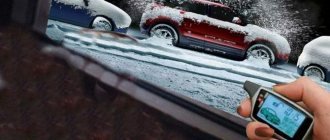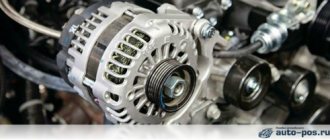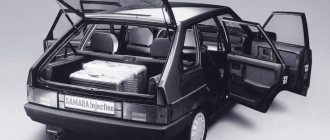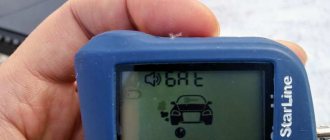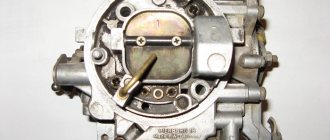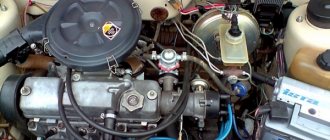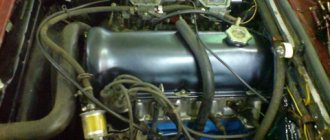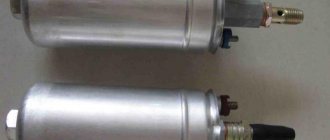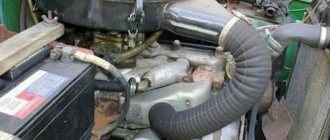It’s an unpleasant situation for every driver - you insert and turn the ignition key, but the car doesn’t start... Immediately the thought: “Why doesn’t the car start, what could have broken down, how much money did I get into this time?...”. Everything is complicated by the fact that there are many reasons for this. The average passenger car consists of 30 thousand parts. And almost every node can cause the car to not start.
A car in the 21st century is not just a means of transportation, but a vital necessity, the basis of our mobility. Do not panic! Let's build a logical chain - what happens when you try to start the engine? Does the starter turn? Is the fuel pump humming? Does the car make any extraneous, uncharacteristic sounds, or is there deathly silence and nothing happens at all? Or does the car start but stall almost immediately?
Pexels
Situation one. The car won't start, the starter won't turn...
The worst thing is when the car shows no signs of life at all. There is a high probability that the problem here is electrical. But what exactly? Just don’t try to squeeze all the juice out of the car and unscrew the key all the way - you’ll also break it...
Completely discharged or dead battery
This is a classic of the genre. Take a multimeter and check the battery. Out of charge? We charge. Died? We buy a new one, preferably more powerful. Don’t rush to throw away a dead battery - many car dealerships offer a discount on the purchase of a new one when you return your old battery.
More often than not, the reason is simpler than it seems. If it’s not -30°C outside, if you’re not a fan of leaving headlights on at night, if the battery has lasted less than five years, check the connection between the battery and the starter. Perhaps there was simply a disconnect. Maybe you need to stretch or clean the terminals (not forgetting the safety rules).
- Auto What classes of cars exist: the alphabet of roaring engines In simple language - from A to F.
Faulty starter
Listen carefully to the sounds. Do you hear any strange clicking sounds? This is a sign that the engine is trying to start, but something is preventing it. And that “something” is usually the starter. The failure may be mechanical or electrical, caused by:
- Contact with liquid at a car wash
- Incorrect operation (for example, abuse of the autorun function)
- Turning the key too hard and too long
- Factory defect
Most often, the starter solenoid relay fails - in this case, replacement is necessary. If you smell a burning smell and nothing spins or rotates, then the starter winding is probably burned out. You can try contacting a car service center, but if you don’t know good auto electricians, it’s better to just buy a new starter. And the difference in price is small, and you won’t waste time dancing with a tambourine in a car service center.
Pexels
Security Bug
A case from one's life. One day the author’s car wouldn’t start in the morning. The answer to the prayers was silence. A car mechanic with 40 years of experience came to the author’s aid. They fussed around the car all day and all evening, but in vain. It was decided to call a tow truck the next morning (towing is not an option, the transmission is automatic). A tow truck arrived and the author thought: “What the hell, I’ll try to start it.” And... the car started! Everything turned out to be trivially simple - the day before the author had driven through a heavy downpour at a rather high speed. Moisture got on one of the sensors, something shorted somewhere. Everything dried out overnight.
As with any electronics, security systems can fail. Maybe you accidentally pressed a fatal combination of keys on the alarm key fob and the anti-theft mode turned on, maybe the battery in the smart key is dead... If the anti-theft system works, try turning the steering wheel left and right while trying to start the engine.
Starting the internal combustion engine. How does this happen
A car engine only works if several conditions are met:
- A sufficient amount of air-fuel mixture enters the cylinders.
- At a certain moment (at the end of the compression stroke), the spark plug generates a spark of the required power.
- The crankshaft and camshaft rotate with strict interaction, ensuring timely filling of the cylinders with the combustible mixture, proper functioning of the gas distribution system and operation of the fuel pump in carburetor internal combustion engines.
By turning the ignition key, the driver supplies power to the starter solenoid relay, which turns on its electric motor and ensures engagement with the crankshaft flywheel ring gear. As the crankshaft rotates, it converts angular momentum into reciprocating motion of the pistons and drives the camshaft (or shafts). The latter ensures timely opening of the valves, due to which the combustion chambers are filled with the fuel mixture at the right time.
Situation two. The starter turns, but does not start
This is a much more common situation, from which no one is immune - neither the owner of a Lada, nor a Mercedes. So, the starter turns, but the matter does not progress beyond this - the car does not start. Why?
Pexels
Dead (less than 12 volt) battery
Let's return to the battery. If the starter turns sluggishly for a few seconds and then stops altogether, then the problem is most likely in the battery. This becomes more frequent with the arrival of winter frosts. But sometimes leaving the headlights or radio on can drain the battery. We check the battery charge and recharge if necessary. If you treat your car with care and do not want to subject it to unnecessary loads, bring the battery home during frosty periods - let the car sit quietly on the street or in the garage. You'll need to travel a little by public transport or by taxi, but then a trouble-free start is guaranteed! This does not work with modern cars, packed with electronics, which require a constantly connected battery.
- FAQ: 8 most unreliable cars (better by taxi)
Faulty generator
The starter turns sluggishly, the car does not start, when the headlights are turned on, they shine somewhat dimly - all these are signs of a poor condition of the generator. Usually the problem lies in a worn belt. Have you recently noticed a quiet whistling sound when the generator is running? It was the belt that gave signals, but you ignored them. Now the car has stopped. Check the belt - if it is worn out, buy a new one (it is inexpensive) and replace it. The old belt may be in good condition, but is just a little loose and needs to be tightened.
Pexels
Spark plug
Some car owners forget that according to the regulations, the service life of conventional spark plugs is 20-30 thousand kilometers. Even if you have driven less in a year, I recommend changing the spark plugs before each winter, especially if the temperature in the region drops to below -30°C. The fact is that over time, black soot forms on the candles - these are soot deposits. The spark plugs let you know that they are in poor condition - engine performance decreases. Have you noticed this? Unscrew the spark plugs and look at their condition. If it is deplorable, we simply change the spark plugs.
It may also happen that during unsuccessful attempts to start the car, you fill the spark plugs with gasoline - because of this, they cannot perform their main function, producing a spark. We unscrew the candles, dry them, blow them; We turn the engine for a few seconds without spark plugs; We return the spark plugs to their place and try to start the engine.
Less specific problems
Let's ignore the lack of fuel in the tank - even a novice amateur should know about the need to monitor the gasoline level. Let's list some rare reasons. Why doesn't the car start if the battery is charged? One of the following mechanisms may be faulty:
- injection pump
- Injectors
- ECU
- Fuel pressure control
Pexels
Checking the ignition system and electronics
Checking the ignition system requires a certain sequence of actions. This step-by-step diagnostic principle allows you to significantly save time and quickly eliminate the malfunction.
This stage involves checking the following components and elements of the ignition system:
- Babina;
- spark plug;
- distributor (breaker-distributor);
- distributor capacitor.
The ignition coil serves to generate the high-voltage voltage necessary to ignite the working mixture. If it starts to act up, the engine may not start. To make sure it works, you need to “throw off” the central wire of the distributor and “short” it to engine ground.
Note: How to choose winter tires for your car
If there is a spark, the coil is good. If not, the spool should be replaced. In most cases, coils become unusable as a result of natural wear and tear. But, there are cases when its “death” occurs after replacing high-voltage wires with non-standard analogues.
If the serviceability of the coil is beyond doubt, we will observe the operation of the spark plugs. First you need to unscrew them and conduct a visual inspection. Particular attention should be paid to the working part where the electrodes are located. If the candles “lead a healthy lifestyle,” their surface is distinguished by the presence of a barely noticeable bluish coating.
If the electrodes are “smoky,” the mixture is over-enriched. If the electrode has a white coating, the engine is experiencing fuel starvation.
After a visual inspection, you need to make sure that a spark is coming from the distributor to the spark plugs. Each candle is brought to the mass of the car at the minimum possible distance.
When cranking the engine with the starter, a spark discharge should occur in the gap between the electrode and the ground.
Distributor
One of the key ignition mechanisms that influences efficient engine starting is the distributor.
Diagnostics of its performance comes down to checking the following elements:
- slider;
- contact Group.
The slider is responsible for supplying a spark to the contacts of the spark plug wires. Therefore, if it fails, the supply of spark directly to the spark plugs will stop. It often happens that the resistor installed in its housing burns out. In this case, after replacing it, the fault is eliminated.
We recommend: How to find out the real mileage of a car when buying
A contact pair consists of a moving and a fixed contact. Each of them has so-called “nickels”. During operation and external influences, they wear out and characteristic marks, the so-called shells, appear on their surface. This significantly reduces the current throughput, which negatively affects sparking. If the degree of wear is insignificant, the contacts are cleaned, after which the gap between them is set with a feeler gauge. When they are critically worn, they must be replaced.
Capacitor
A capacitor is placed on the distributor body. It is designed to generate more voltage on the secondary winding of the coil. Checking its serviceability will not take much time.
To do this, use a regular 12V car light bulb. A lamp is connected to the gap between the coil and the capacitor. If it lights up, the capacitor is faulty. The lamp does not light - the capacitor is working.
Situation three. The car starts and stalls after a few seconds
Is your car having trouble starting? The reasons may vary. It would seem that this is the lesser of two evils - after all, the car starts! But the fact that it immediately stalls can cost a pretty penny...
Compression drop in cylinders
This often occurs at high air humidity. If you have a diesel, then it works a little differently than its gasoline counterpart. Due to the drop in compression, diesel fuel does not ignite, which is a sign of wear on the cylinders and o-rings. I don’t want to upset you, but perhaps the engine is due for a major overhaul...
- Style Dirt as a canvas: artists who turn unwashed cars into art If for you a dirty car is just a dirty car, then you have nothing to do with modern street art. But if glass and body panels covered with dust and streaks of dirt awaken the desire to create, you will be welcome in the still small Dirty Car Art community.
Dirty filters
Let's remember the technical regulations again. This applies to both fuel and air filters. The engine requires clean gasoline to operate properly. Clogged filters do not cope with their main function - preventing dust and dirt from entering the engine. Dirt particles and various impurities prevent gasoline from igniting normally, so the engine starts and immediately stalls.
Pexels
Gasoline pump
Owners of cars with injection engines should read this paragraph. It is quite easy for a person with good hearing to identify problems in the fuel system. In silence, you need to turn the key to the ignition position - a characteristic, quiet buzzing sound should sound. This means the fuel pump is working. Doesn't it buzz? This means that either he died or there was another malfunction in the fuel system. This could be frozen water in the fuel line, a disconnected contact in the circuit, or even a blown fuse. The check should start with the fuse. Didn't it burn out? Then we check the presence of fuel at the Schrader valve. If it is not there, you need to contact a car service - I categorically do not recommend getting into the fuel system yourself.
- Jokes The amazing is nearby: 20 “surprises” that auto mechanics discovered in cars. Get ready to hold your jaw, what you won’t see in car interiors.
Timing chain or belt
This is a fairly non-specific problem in this situation, since problems with the timing belt are difficult to miss. If the car starts and immediately stalls, while you do not have time to move, the belt may have simply fallen off the correct tooth or broken. It's not so sad. It is much worse if a broken belt leads to bending of valves, deformation of connecting rods, and destruction of the cylinder head. In this case, the engine itself will have to be repaired.
Pexels
Less popular reasons
As in the previous situation, when the car does not start well, there may be different reasons - we have listed the most common ones above, but the root of the problem may lie in a malfunction of the following elements:
- Throttle valve (for carburetors). In this case, problems make themselves felt when the engine is cold.
- Oxygen sensor. Unfortunately, this device, also called a lambda probe, cannot be repaired. Replacement required
- Attachments that are “jammed.” This could be the air conditioning compressor, alternator, or power steering pump.
- Crankshaft position sensor (CPS). The on-board computer will probably give an error. The starter will rotate, the car will even be able to start, but it can also stall at any moment
Timing belt broke
VAZ 2110 does not start, the starter turns - perhaps the reason lies in a broken timing belt?
The engine gas distribution mechanism is driven by the crankshaft gear. Initially, chains were used for this purpose, and timing belts, which began to be widely used about twenty years ago, aroused mistrust among car owners.
The undoubted advantages of a belt drive over a chain drive are its simple design, low weight and low noise. However, it is not without its drawbacks, the main one of which is the relatively short resource of the timing belt.
Of course, a faulty, torn or misaligned timing belt also causes the VAZ 2110 to fail to start. By the way, on stock, non-deformed models of the 21120 engine, a torn timing belt also causes valve deformation and requires additional repairs. In this case, driving even after replacing the belt without restoring the valves is impossible.
New timing belt VAZ 2110
Check for the presence of a spark in the spark plugs visually by turning on the ignition and pressing the outer metal part of the spark plug against the unpainted metal body of the car or against structural elements. Do not forget that all electrical parts of the product are under high voltage, so it is better to carry out work with insulating gloves. If there is no spark on only one spark plug, be sure to check the others and draw the appropriate conclusions.
The consequences of a broken timing belt depend entirely on the design of the power unit. To imagine what will happen at this moment, you need to turn to the mechanics of the internal combustion engine.
In a running engine, the pistons continuously move from one dead center to another. During the intake stroke, the piston moves down and the intake valve opens; during the exhaust stroke, the exhaust valve opens and the piston moves up. At the moment when the piston is at top dead center, all valves must be closed. If the timing belt breaks, the camshaft stops rotating and the valves stop in one position. At the same time, the crankshaft continues to rotate by inertia, and the pistons rush towards the open valves.
Timing belt VAZ 2110 OPEN
In some engines, for example, the 8-valve VAZ-2111, the pistons have special recesses to avoid contact with the valves in the event of a break. In this case, there will be no consequences, except that the car will not be able to get to the garage or workshop under its own power.
conclusions
So, in this article we remembered the reasons why the car won’t start and what to do if this problem overtakes you. We can advise you to monitor the condition of the car - the tank should be full, the battery should be charged, all consumables should be changed on time. Listen to the sounds from under the hood, as soon as you notice any deviations from the norm - contact a car service, or at least look for a solution to the problem on the Internet. Responsible and careful car ownership will protect you not only from the car not starting, but also from other troubles on the road.
- Style Gold of Russia: how Aurus became an airplane from a car The project, which began as a car for the President of Russia, eventually grew into a whole philosophy.
- Author: Alexander Ponomarev
Reason #4: Throttle
The situation is approximately the same as with the fuel filter. If the valve is clogged, there may not be enough fuel to operate the engine or it may not flow there at all. The throttle body can be cleaned using carburetor cleaner and a brush; after cleaning, it is necessary to blow out the throttle body with compressed air.
When cleaning the throttle valve, it is worth remembering that on cars equipped with an on-board computer, it is necessary to “accustom” the system to the fact that the throttle valve is clean again. Because due to contamination, the on-board computer independently sets the damper to a certain position.
